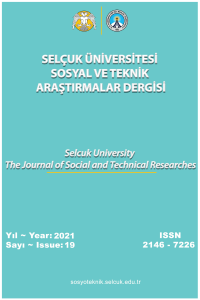THE PERCEPTIONS OF THE CUSTOMERS STAYING AT HOTELS TOWARDS ONLINE SHOPPING
THE PERCEPTIONS OF THE CUSTOMERS STAYING AT HOTELS TOWARDS ONLINE SHOPPING
Via the developments in Web 2.0 technology, customers can shop online using computers and smart phones. With the purpose of increasing their share in the industry, the companies that conceived the importance of internet shopping aim at making their all products available for their current and potential customers. Understanding how online shopping is organized and patterned is significant for companies. Thus, the aim of this paper is to measure the perceptions of the customers staying at hotels regarding online shopping. To achieve the goals of this study, a study was undertaken on 386 customers who preferred to stay at 5-star hotels in Afyon to see the effect of using internet as a tool of promotional activity after the manufacturing of the products that satisfy the needs and wishes of current and potential customers. Convenience sampling is utilized in this study. In the study the data which is obtained through a face-to-face survey was analysed using SPSS 22.0, the statistical package for social sciences.
___
- ARMAĞAN, Ece A. ve TURAN, Aykut H. (2014). İnternet Üzerinden Alışveriş: Demografik Faktörlerin, Bireysel İhtiyaçların Etkisi Üzerine Ampirik Bir değerlendirme Atatürk Üniversitesi İktisadi ve İdari Bilimler Dergisi, Cilt: 28, Sayı: 3.
- DPT, Bilgi Toplumu Dairesi Başkanlığı. (2015), 2015-2018 Bilgi Toplumu Stratejisi ve Eylem Planı, http://www.bilgitoplumu.gov.tr/yayinlar/ (20.07.2015)
- DÜNDAR, Süleyman ve YÖRÜK, Durmuş. (2009) “Tüketicilerin İnternetten Alışverişe Karşı Tutumlarında Etkili Faktörler”, İktisat İşletme ve Finans, 24 (278) 2009: 92-109.
- ENGİNKAYA, E. (2006). Elektronik Perakendecilik ve Elektronik Alışveriş, Ege Akademik Bakış Dergisi, 6 (1) 10-16.
- HEIDARI, K. (2009). The Impact Of Semantic Web on E-commerce, World Academy of Science, 51:303-306
- KÜPOĞLU, Can. (2008). Dünya'da Ve Türkiye'de Perakendecilik Ve E-ticaret Karşılaştırması, Yüksek Lisans Tezi, Marmara Üniversitesi Sosyal Bilimle Enstitüsü, İstanbul.
- LIAN, J. W., & LIN T. M. (2007). Effects of consumer characteristics on their acceptance of online shopping: Comparisons among different product types. Computers in Human Behavior, 24(1), 48–65.
- MERT, Gözde. (2012). İnternet Üzerindeki Alışverişlerde, Alıcının Duygu Ve Beklentilerinin, Satış Üzerine Etkileri, Organizasyon ve Yönetim Bilimleri Dergisi Cilt 4, Sayı 2, ISSN: 1309 -8039 (Online)
- ODABAŞI, Yavuz ve Mine Oyman. (2007), Pazarlama İletişimi Yönetimi, İstanbul: Media Cat Yayınları.
- SEXTON, Don. (2008), Pazarlama 101: Pazarlamanın En Güçlü Fikirleri Daha Fazla Müşteri Edinmek ve Onları Tutmak için Nasıl Kullanılır?, Çeviri: N. Kıvılcım Yavuz, İstanbul: Media Cat Yayınları.
- SİLKÜ, H. Aydan. (2009). İletişim Fakültesi Öğrencilerinin İnternetten Alışverişe Yönelik Tutumları. Journal of Yaşar University, 4 (15), 2281-2301.
- SIM, L.L. ve S. M. Koi. (2002). “Internet Shopperes and Their Impact on Traditional Shopping Patterns”, Journal of Retailing and Consumer Services”, 9, 115-124.
- ŞAHİN, İrem (2014), Elektronik Perakendecilik Sektörü Ve İnternet Alışverişi Tüketici Davranışı: Türkiye Örneği, Yüksek Lisans Tezi, Gaziantep Üniversitesi Sosyal Bilimler Enstitüsü, Gaziantep.
- TEO, T.S.H. (2006). “To Buy or not to Buy Online: Adopters and Non-Adopters of Online Shopping in Singapure”, Behaviour and Information Technology, 25, 6, 497-509.
- Türkiye İstatistik Kurumu (TUİK) (2016). Hane Halkı Bilişim Teknolojileri Kullanımı Araştırması, www.tuik.gov.tr/PdfGetir.do?id=21779. (20.09.2016).
- USTA, R. (2006). Tüketicilerin Demografik Özellikleri ve İnternetten Satın Alma Davranışı Üzerine Bir Araştırma, Kooperatifçilik, 41 (3), 1-13.
- VURAL, İlhami ve ÖZ, Mustafa.. (2007), “Bir Reklam Mecrası Olarak İnternet”, Erciyes Üniversitesi Sosyal Bilimler Enstitüsü Dergisi, Sayı: 23, s. 221-240.
- Başlangıç: 2011
- Yayıncı: Selçuk Üniversitesi
Sayıdaki Diğer Makaleler
TARİHİ YAPILARDA GÖRÜLEN HASAR TÜRLERİ
M.sami DÖNDÜREN, Özlem ŞİŞİK, Atila DEMİRÖZ
TÜRKİYE’DE SURİYELİ GÖÇMENLERE YÖNELİK YAPILAN EĞİTİM ÇALIŞMALARI
Handan ERTAŞ, Fatma ÇİFTÇİ KIRAÇ
TÜRKİYE’ DE KRİZ VE AFET YÖNETİMİ MEVZUATININ DEĞERLENDİRİLMESİ
USAGE OF INTERACTIVE TECHNOLOGIES IN TOURISM GUIDANCE EDUCATION
Ahmet BÜYÜKŞALVARCI, İsa ALTINIŞIK, Özlem TEKİN
THE PERCEPTIONS OF THE CUSTOMERS STAYING AT HOTELS TOWARDS ONLINE SHOPPING
TÜRKİYE’DEKİ TRAFİK KAZALARININ YUVARLANMA GM(1,1) MEKANİZMASI İLE TAHMİNİ
Erol TURAN, Emre AYDİLEK, Hayati TABAN
ENTROPİ TEMELLİ MAUT YÖNTEMİNE GÖRE DEVLET ÜNİVERSİTELERİ KÜTÜPHANELERİNİN DEĞERLENDİRİLMESİ
